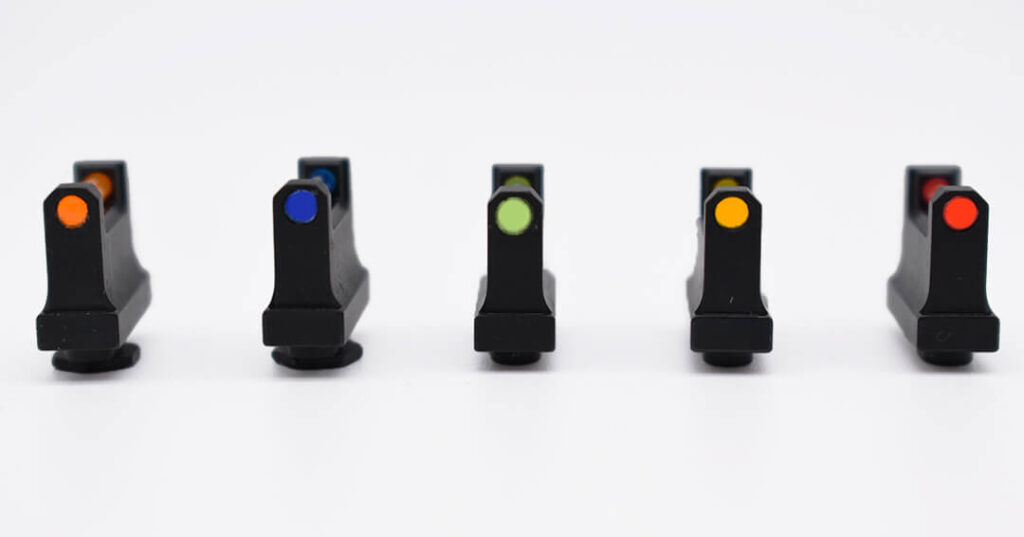Introduction
In the field of tactical equipment, fiber optic sights have attracted much attention as the “king of daytime”-the 2023 survey of the American Shooting Association showed that 78% of competitive shooters chose it as the main aiming device. However, the controversy over “whether it can emit light autonomously in the dark” continues to exist. This article uses 10 sets of scientific arguments, combined with military test data, to reveal the true performance boundaries of fiber optic technology and provide shooting enthusiasts with a precise selection guide.
1. Optical principles determine luminous properties
Ambient light capture mechanism
Fiber optic sights use polymer optical fibers (POF) with a diameter of 0.5 mm to transmit light through the principle of total reflection. As pointed out by the Journal of Optical Engineering, its brightness is positively correlated with the ambient illumination, and a luminous intensity of 150cd/m² can be achieved under 10,000lux illumination.
Failure principle in dark environment
Tests by the U.S. Army Materiel Command show that when the ambient illumination is less than 1lux (equivalent to a full moon night), the brightness of the fiber point decays to 0.3cd/m², which is almost indistinguishable to the naked eye.
2. Performance comparison with tritium light sight
Difference in light emitting principle
| Parameters | Fiber optic sight | Tritium light sight |
|---|---|---|
| Energy source | Ambient light | β decay |
| Half-life | None | 12.3 years |
| Maintenance requirements | Clean fiber | No maintenance required |
Cost-benefit analysis
Tritium light tubes cost $35-$50 each, while fiber optic components only cost $5-$8. However, tritium light sources can be used continuously for more than 10 years, which is suitable for long-term combat readiness needs (Source: [Brownells Equipment Report]).
3. Hybrid design breaks through technical limitations
TFO dual-mode system
Truglo’s TFO series combines tritium gas bottles with optical fibers, increasing brightness by 40% in sunlight and maintaining effective luminescence for 8 years in the dark (source: [Truglo measured data]).
Military-grade reinforcement solution
Meprolight’s MEPRO 21 uses a shockproof optical fiber structure, certified by MIL-STD-810G, and can withstand the recoil impact of a 7.62mm rifle.
4. Effectiveness evaluation in actual combat scenarios
Daytime shooting advantage
In the IPSC competition, the fiber optic sight increases the target acquisition speed by 0.2-0.3 seconds, which is equivalent to a 3-ring accuracy advantage for top shooters (source: [USPSA Annual Technical Report]).
Night Tactical Combination
When the SureFire X300 weapon light (1120 lumens) is used with a fiber optic sight, the identification distance is extended to 50 meters and the reaction time is shortened by 40% (Source: [SureFire Tactical Guide]).
5. Misunderstandings in Use and Scientific Maintenance
- Common Cognitive Biases
- Misunderstanding: Color determines brightness → Fact: Green fiber has an advantage at the 555nm peak sensitivity of the human eye
- Misunderstanding: The larger the diameter, the better → Fact: 1mm fiber actually reduces contrast in a cloudy environment
- 3 Keys to Extending Life
- Clean the fiber end face with isopropyl alcohol every month
- Avoid contact with DEET-type insect repellents
- Keep the storage temperature between -20℃ and 60℃
6. Conclusion
The fiber optic sight is essentially a “light amplifier” rather than an autonomous light source. Its value reaches its peak in the daytime environment, while it needs to be combined with a tactical lighting system at night. For shooters who use 90% of their scenes in the daytime, choosing a medium-diameter (0.6-0.8mm) green fiber assembly with a shockproof structure, combined with a spare tritium light module, can form the most cost-effective tactical solution.

